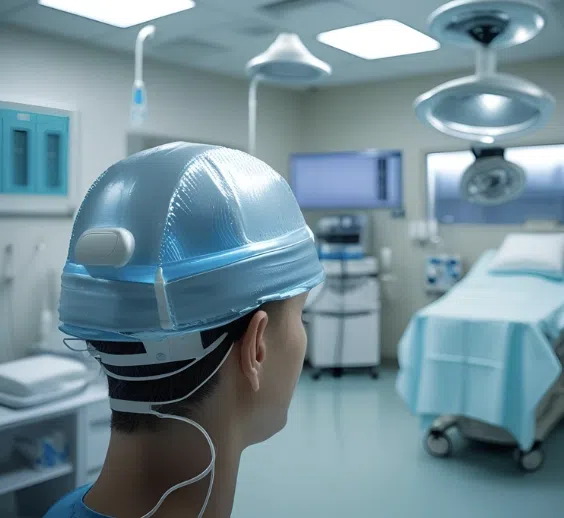Protecting Your Hair and Nerves During Chemotherapy:
How Cold Caps and Cold Booties Can Help
Cancer treatment is challenging, but you are not powerless. You can take steps to protect your body from some of the side effects of chemotherapy. Two tools that can help are cold caps and cold booties (and gloves). These devices use cold temperatures to reduce hair loss and nerve damage during chemotherapy infusions.

Why Chemotherapy Causes Hair Loss and Nerve Damage
Chemotherapy works by attacking rapidly dividing cells. This includes cancer cells, but also healthy cells that grow quickly, such as:
- Hair follicle cells – leading to hair thinning or complete hair loss.
- Nerve cells in your hands and feet – causing numbness, tingling, or pain, a condition called peripheral neuropathy.
Hair loss can be emotionally devastating. Nerve damage can interfere with daily activities and may last long after treatment ends. This is why prevention matters.
How Cold Caps and Cold Booties Work
Cold caps and booties use scalp and limb cooling therapy, also called cryotherapy. The cold temperature:
- Narrows blood vessels in the scalp, hands, and feet.
- Reduces blood flow to these areas during chemotherapy infusion.
- Limits the amount of chemotherapy drugs reaching the hair follicles and nerves.
- Protects cells from damage without affecting cancer treatment.
This cooling process is safe for most patients and has been shown in studies to significantly reduce hair loss and nerve injury.
How to Use Cold Caps, Booties, and Gloves Properly
To be effective, timing and consistency matter.
- Cold caps must be worn 30–45 minutes before chemotherapy, during the infusion, and for 60–90 minutes after.
- Cold booties and gloves should be worn 15 minutes before infusion and kept on for the entire treatment plus 15–30 minutes after.
- They must stay cold throughout the treatment, so you may need multiple caps or booties that are rotated and kept in a freezer or on dry ice.
Your infusion center may provide these devices, or you may need to rent or purchase them. Always work with a trained technician or follow manufacturer instructions closely.
Who Should Not Use This Therapy
Not everyone is a candidate for cooling therapy.
- Patients with certain blood cancers (like leukemia or lymphoma) are often advised to avoid scalp cooling because cancer cells circulate in the blood.
- Patients with cold sensitivity conditions (such as Raynaud’s disease) or circulatory problems should not use this therapy.
- If you have scalp metastases, scalp cooling is not recommended.
Always discuss with your oncologist before starting.
Taking Control of Your Cancer Journey
You deserve a plan for your health, not just a plan for your disease. Cold caps and cold booties give you a way to protect your body while undergoing treatment. They do not interfere with the effectiveness of chemotherapy, and they can help you maintain your quality of life.
Cancer is not in control. You are.
With the right tools and knowledge, you can create a body where cancer cannot thrive.
To your health, healing, and wholeness,
Dr. Nalini Chilkov
BONUS CHECKLIST
How to Prepare for Cold Cap and Cold Bootie Therapy
Preparation makes your experience easier and more successful. Use this checklist to stay comfortable and get the best results:
✅ Before Your Infusion Appointment
- Talk to your oncologist to confirm you are a good candidate.
- Arrange for a helper – cold caps often need to be changed by someone during treatment. Or coordinate with the oncology nurse team at the infusion center.
- Reserve or rent the equipment well in advance (caps, gloves, booties, dry ice or freezer packs). You can purchase supplies online.
- Read all instructions from the manufacturer so you know the timing and steps
- Chill the caps, booties and gloves in advance and bring to your appointment in a portable cooler or chest if the infusion center does not provide these for you.
✅ What to Bring on Treatment Day
- Chilled Cold caps, gloves, and booties (plus backup sets to keep them cold).
- Coolers with dry ice or medical-grade freezers to keep items at the right temperature.
- Soft headband or ear covers to protect ears from extreme cold.
- Warm blankets, socks, and layered clothing to keep your body warm while your scalp, hands, and feet are cold.
- Snacks and warm drinks to stay comfortable during long sessions.
- A timer or phone alarm to track when to switch caps or booties.
- Distraction items like music, audiobooks, movies to watch on your laptop or a friend to pass the time.
✅ After Treatment
- Keep your scalp protected: avoid hot showers, hair dryers, or harsh chemicals for several days.
- Continue using gentle hair care to minimize breakage.
- Monitor your hands and feet for any lingering numbness or discomfort and report it to your care team.
By preparing ahead, you will reduce stress and increase the effectiveness of your cooling therapy. And you just might keep most of your hair and avoid painful nerve damage in your hands and feet.




